
Notes on
Reality Is Not What It Seems
by Carlo Rovelli
• 2 min read
“It is characteristic of genius to be aware of the limitations of its own findings, even in the case of such momentous outcomes as Newton’s discovery of the laws of mechanics and universal gravity.”
“You don’t get to new places by following established tracks.”
To understand an idea, start with the fundamentals. Go to the roots.
For it is easier to understand ideas by starting with the roots from which they have grown, and an important number of the ideas which turned out to be effective for understanding the world originated over two thousand years ago. If we briefly retrace their birth, they become clearer, and the later steps turn out to be simpler and natural.
The start of scientific thinking
The Milesians understand that by shrewdly using observation and reason, rather than searching for answers in fantasy, ancient myths or religion – and, above all, by using critical thought in a discriminating way – it is possible to repeatedly correct our world view, and to discover new aspects of reality which are hidden to the common view. It is possible to discover the new.
The first experiment
“For the first time in the history of mankind, an experiment is made. Experimental science begins with Galileo. His experiment is simple: he lets objects fall; that is, he lets them follow what for Aristotle was their natural movement and seeks to measure precisely their falling speed.”
The first experiment. He discovers acceleration, which is the rate at which speed increases. He finds it to be 9.8 metres per second per second. So for every second an object falls, it falls 9.8 metres per second faster.
Liked these notes? Join the newsletter.
Get notified whenever I post new notes.